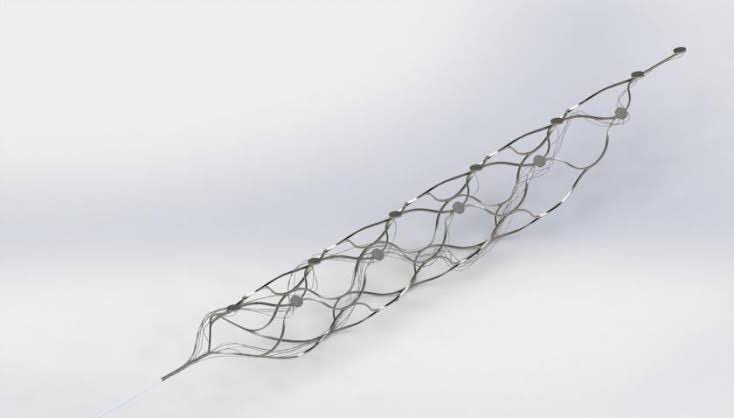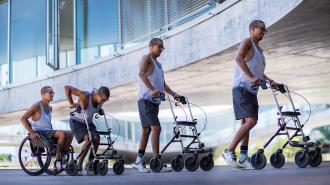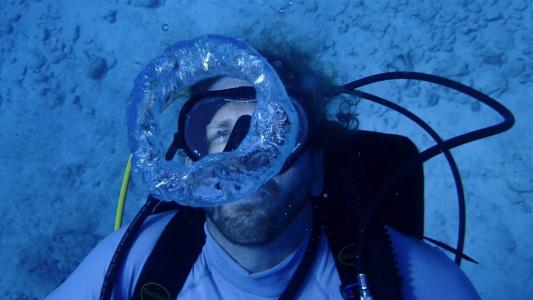This article is an installment of Future Explored, a weekly guide to world-changing technology. You can get stories like this one straight to your inbox every Thursday morning by subscribing here.
If you want to do so much as lift a finger, an electrical signal needs to be able to travel from your brain down to the digit. A problem with the nervous system anywhere along this path — in your brain, spinal cord, arm, etc. — can cause paralysis in your hand, meaning you can no longer move it voluntarily.
Nearly 2% of people living in the US experience some level of paralysis in their arms or legs, but thanks to groundbreaking innovations in neuroscience, we’re seeing that forms of paralysis long assumed to be permanent can be reversed — and even more exciting breakthroughs are on the horizon.
Brain computer interfaces
How it works: Brain computer interfaces (BCIs) can bypass damage in the spinal cord, limbs, or nerves, using electronics to get commands from the brain to muscles.
The process starts by detecting the electrical signals in the brain when a person thinks about moving their paralyzed body part — this can be done using implanted electrodes or an electroencephalogram (EEG) cap.
The signals are then sent to a computer that turns them into commands for the muscles. Those signals are delivered to the muscles using electrodes positioned on the outside of the affected limb or under the skin, right on top of the muscle.
Where we are now: BCIs aren’t science fiction — we’ve seen many examples of these devices actually restoring arm and leg movement in people paralyzed by spinal cord injuries. Still, BCIs are a very experimental approach to reversing paralysis, limited mostly to small trials in labs.
The drawbacks: Implanted electrodes are more invasive than EEG caps, but they can record brain signals at much higher resolutions, which can make it easier for a BCI to accurately translate thoughts into commands.
But scar tissue tends to form around implants, degrading the signal strength over time — the longest we’ve seen an implanted electrode power a BCI is seven years.
Several promising implant advances could extend the durability of BCIs.
Looking ahead: A number of promising implant advances could extend the durability of BCIs and help get them out of labs and into patients.
Tech company Synchron is currently trialing a matchstick-sized implant called the “Stentrode” in people — it’s designed to record signals from inside a blood vessel in the brain, which Synchron says makes the implantation procedure much less risky and eliminates the issue of scar tissue.
A new implant developed at the University of Cambridge and tested in mice places a layer of stem cells between the electrodes and living tissue. These cells can be programmed to become brain cells, spinal cells, or muscle cells, depending on where the implant is being placed.
“By putting cells in between the electronics and the living body, the body doesn’t see the electrodes, it just sees the cells, so scar tissue isn’t generated,” said co-lead researcher Damiano Barone.

Spinal stimulators
How it works: Spinal cord injuries are a common cause of paralysis, but you don’t always need a BCI to completely reroute a signal around the damage.
Spinal stimulators deliver precise electrical stimulation to the nerves of the spinal cord — this general stimulation appears to boost any natural brain signals that do make it through the damage, helping restore movement in paralyzed limbs.
The electrodes connect to a battery pack, typically implanted in a patient’s abdomen or the top of their buttocks. The stimulation is usually controlled by an external device, such as a tablet, and it can be adjusted for different activities.
Where we are now: Over the past decade, we’ve seen significant progress in reversing paralysis with spinal stimulation, with some patients regaining some movement in their lower extremities in 2014.
Now, at least a dozen people with spinal cord injuries that had left them paralyzed from the waist down can walk again thanks to a spinal cord stimulator developed in Switzerland — in some cases, they were able to take steps on a treadmill the day after implantation.
It can also work for other causes of paralysis. Two patients with partial paralysis due to stroke were able to regain some voluntary movement thanks to spinal cord stimulators placed in their necks by researchers from Carnegie Mellon University and the University of Pittsburgh.
Some of their added mobility was even retained for weeks after the implants were removed when the study ended.
Spinal stimulators boost the brain signals that make it past the site of a spinal cord injury.
The drawbacks: The Swiss spinal cord stimulator uses an electrode array that’s 6 centimeters long. Unlike spinal stimulators designed to treat back pain, which can be put in place with a needle, patients must undergo invasive surgery to have this larger device implanted.
Once in place, researchers say the electrode should be able to deliver stimulation indefinitely, but patients will need to undergo surgery to have the battery pack that powers it — which was implanted in their abdomens — replaced every nine years.
The spinal stimulator used in the stroke patients can be implanted with minimally invasive surgery, but was removed less than a month after implantation, so we don’t know how well it would work long term.
Looking ahead: The use of spinal stimulators to reverse paralysis is still new territory, and larger trials are needed to prove their efficacy and safety — the Pittsburgh team’s ongoing trial is expected to enroll 13 more people, and the Swiss team is gearing up for trials involving 50 to 100 participants.

Stem cells
How it works: We have about 200 different types of cells in our bodies, but before they differentiated into one type or another, they all started out as stem cells. When stem cells are injected at the site of a paralysis-causing injury, they can help regenerate damaged tissue.
Where we are now: In 2016, a small trial out of Stanford University found that injecting stem cells into the brains of stroke survivors could improve their motor function, giving some participants who had been in wheelchairs the ability to walk.
Stem cell injections into the spine have also successfully reversed paralysis in some people with spinal cord injuries, and adding stem cells to the patches used to treat the birth defect spina bifida appears to help prevent paralysis in children.
Stem cells can help regenerate damaged tissue at the site of a paralysis-causing injury.
The drawbacks: Stem cell treatments are still experimental, and while we’ve seen some trial participants gain significant mobility, others in the same trials see little to no benefit at all — the therapy simply isn’t reliable.
In some cases, patients even end up in a worse position after stem cell treatment — a type of stem cell transplant that had shown promise in animal models caused a man with paralysis additional pain and led to the development of a benign tumor in his spine years later.
“The worst-case scenario is not necessarily that [stem cell therapy] doesn’t work,” Nanette Hache, one of the man’s physicians and a professor of radiology at Memorial University of Newfoundland, told STAT in 2019. “There can be other complications, such as tumor formation.”
Looking ahead: With more research, we might be able to answer the many lingering questions preventing stem cells from being a reliable, safe way to reverse paralysis, such as what types of cells to use, in what dosages, and when and how to administer them.
Today’s solutions
BCIs, spinal stimulators, and stem cells are a few of the most promising avenues to reversing paralysis, but they aren’t the only ones — researchers are also seeing encouraging results from gene therapies, synthetic molecules, and nerve transfers.
While researchers continue to develop these therapies to reverse paralysis, we can lean on technologies such as exoskeletons, home robots, and mind-controlled prosthetics to improve the lives of people living with the condition.
We’d love to hear from you! If you have a comment about this article or if you have a tip for a future Freethink story, please email us at [email protected].






